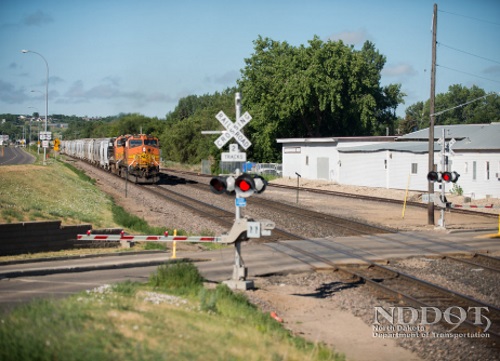The North Dakota Department of Transportation is currently developing a State Freight & Rail Plan or SFRP as part of an effort to create a “comprehensive view” of the statewide movement of goods.
[Above photo by the North Dakota DOT]
To that end, the agency said in a statement its SFRP would assess all modes moving freight within North Dakota, identifying needs and issues to create a roadmap for future investment in the state’s multimodal transportation system, and serve as a roadmap for future investment.

The agency added that it plans to use online engagement opportunities, surveys, videos, social media, and direct conversations with residents to collect information to help shape the future of multimodal freight systems in North Dakota.
Several state departments of transportation across the country are developing similar freight plans to help guide future multimodal transportation system investments as well.
For example, the California Department of Transportation released its California Freight Mobility Plan 2020 alongside the final two of 12 district-based Climate Change Vulnerability Assessment Reports in July 2020 – strategic documents aimed at making the state’s transportation system more efficient and resilient to extreme weather events.

Toks Omishakin, director of Caltrans, noted that his agency’s freight plan details the immediate and long-term policies, strategies and investments necessary to support the ever-evolving, complex network for transporting goods – “whether by truck, train, ship, airplane, automobile, bicycle, foot or robot.”
The plan also highlights ways to lessen the freight system’s “negative environmental impacts,” particularly on low-income communities near trucking corridors, by reducing greenhouse gas emissions, he said.
Freight volumes are growing significantly across the United States, according to the latest version of the Freight Analysis Framework or FAF jointly issued by the Federal Highway Administration and Bureau of Transportation Statistics.
The new five-year FAF estimates released in March show that nearly 20 billion tons of goods worth almost $19 trillion moved on the U.S. transportation network in 2017, meaning that on average 54 million tons of goods valued at $52 billion per day moved throughout the country on all transportation modes. Value comparisons are in current dollars.
FHWA noted that it releases FAF benchmarks at five-year intervals and that they incorporate BTS Commodity Flow Survey data, international trade data from the Census Bureau, and data directly from specific economic sectors such as agriculture, energy extraction, utility, construction, and the service industry, among others.
 States
States
Dina El-Tawansy Appointed Director of Caltrans
July 11, 2025 States
States

